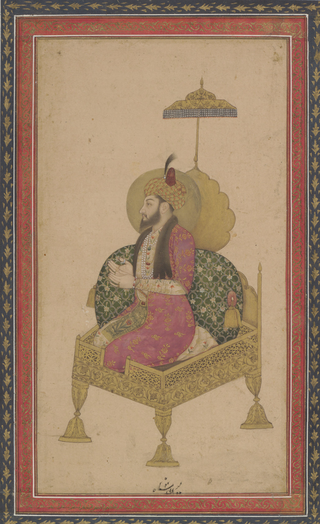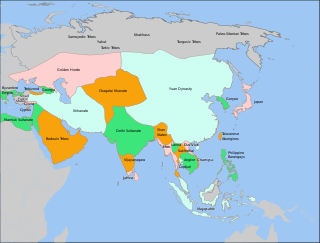
The Battle of Ankara or Angora was fought on 20 July 1402 at the Çubuk plain near Ankara, between the forces of the Ottoman sultan Bayezid I and the emir of the Timurid Empire, Timur. The battle was a major victory for Timur, and it led to the Ottoman Interregnum.

The Timurid Empire was a late medieval, culturally Persianate Turco-Mongol empire that dominated Greater Iran in the early 15th century, comprising modern-day Iran, Iraq, Afghanistan, much of Central Asia, the South Caucasus, as well as parts of contemporary Pakistan, North India and Turkey. The empire was culturally hybrid, combining Turko-Mongolian and Persianate influences, with the last members of the dynasty being "regarded as ideal Perso-Islamic rulers".

The Chagatai Khanate, or Chagatai Ulus was a Mongol and later Turkicized khanate that comprised the lands ruled by Chagatai Khan, second son of Genghis Khan, and his descendants and successors. At its height in the late 13th century the khanate extended from the Amu Darya south of the Aral Sea to the Altai Mountains in the border of modern-day Mongolia and China, roughly corresponding to the area once ruled by the Qara Khitai.

Mirza Jalal-ud-din Miran Shah Beg, commonly known as Miran Shah, was a son of the Central Asian conqueror Timur, founder of the Timurid Empire.

The Turco-Mongol or Turko-Mongol tradition was an ethnocultural synthesis that arose in Asia during the 14th century, among the ruling elites of the Golden Horde and the Chagatai Khanate. The ruling Mongol elites of these Khanates eventually assimilated into the Turkic populations that they conquered and ruled over, thus becoming known as Turco-Mongols. These elites gradually adopted Islam as well as Turkic languages, while retaining Mongol political and legal institutions.
Bagrat V the Great from the Bagrationi dynasty was the son of the Georgian king David IX of Georgia by his wife Sindukhtar Jaqeli. He was co-ruler from 1355, and became king (mepe) after the death of his father in 1360.

George VII was king (mepe) of Georgia from 1393 to 1407. Bagrat V's son and successor, George put up a stiff resistance and had to spend much of his reign fighting Timur and his Empire.

The Tokhtamysh–Timur war was fought from 1386 to 1395 between Tokhtamysh, khan of the Golden Horde, and the warlord and conqueror Timur, founder of the Timurid Empire, in the areas of the Caucasus Mountains, Turkestan and Eastern Europe. The battle between Amir Timur and Tokhtamysh played a key role in the decline of Mongol power over early Russian principalities.

Moghulistan, also called the Moghul Khanate or the Eastern Chagatai Khanate, was a Mongol breakaway khanate of the Chagatai Khanate and a historical geographic area north of the Tengri Tagh mountain range, on the border of Central Asia and East Asia. That area today includes parts of Kazakhstan, Kyrgyzstan, and northwest Xinjiang, China. The khanate nominally ruled over the area from the mid-14th century until the late 17th century.

The Timurid invasions of Georgia were eight invasions between 1386 and 1403 of the Kingdom of Georgia in the Caucasus by the Timurid Empire. Led by Timur, the Timurids ultimately conquered Georgia and made it a tributary state. However, Georgia, a Christian monarchy, was allowed to retain its independence and remain Christian.
The Dughlat clan was a Mongol clan that served the Chagatai khans as hereditary vassal rulers of several cities in western Tarim Basin, in modern Xinjiang, from the 14th century until the 16th century. The most famous member of the clan, Mirza Muhammad Haidar, was a military adventurer, historian, and the ruler of Kashmir (1541–1551). His historical work, the Tarikh-i Rashidi, provides much of the information known about the family.

Timur or Tamerlane was a Turco-Mongol conqueror who founded the Timurid Empire in and around modern-day Afghanistan, Iran, and Central Asia, becoming the first ruler of the Timurid dynasty. An undefeated commander, he is widely regarded as one of the greatest military leaders and tacticians in history, as well as one of the most brutal and deadly. Timur is also considered a great patron of art and architecture as he interacted with intellectuals such as Ibn Khaldun, Hafez, and Hafiz-i Abru and his reign introduced the Timurid Renaissance.
Anna Megale Komnene was a Trapezuntine Queen consort of Georgia as the second wife of King Bagrat V. She was the mother of his youngest son, Constantine I of Georgia, who would in 1407 succeed his half-brother, King George VII, and reign as king.
Justin Marozzi is an English journalist, historian and travel writer.

The Siege of Balkh was a key success in Timur's rise to power, and established him as the ruler of the western Chagatai Khanate in Transoxiana.

Qamar-ud-din Khan Dughlat was a Mongol ruler of Moghulistan between 1368 and 1392. He belonged to the Dughlat clan of Mongol warlords.

The Samtskhe-Saatabago or Samtskhe Atabegate, also called the Principality of Samtskhe, was a Georgian feudal principality in Zemo Kartli, ruled by an atabeg (tutor) of Georgia for nearly three and a half centuries, between 1268 and 1625. Its territory consisted of the modern-day Samtskhe-Javakheti region and the historical region of Tao-Klarjeti.

The Timurid conquests and invasions started in the seventh decade of the 14th century with Timur's control over Chagatai Khanate and ended at the start of the 15th century with the death of Timur. Due to the sheer scale of Timur's wars, and the fact that he was generally undefeated in battle, he has been regarded as one of the most successful military commanders of all time. These wars resulted in the supremacy of Timur over Central Asia, Persia, the Caucasus and the Levant, and parts of South Asia and Eastern Europe, and also the formation of the short-lived Timurid Empire. Scholars estimate that his military campaigns caused the deaths of 17 million people, amounting to about 5% of the world population at the time.
Sultan Husayn Tayichiud was a noble of the Timurid Empire and a maternal grandson of its founder, the Central Asian conqueror Timur. Sultan Husayn held prominent positions in the Imperial army and accompanied his grandfather on several of his military campaigns. He was executed by his uncle Shah Rukh during the war of succession following Timur's death.

The Kingdom of Western Georgia was a late medieval de facto independent fragmented part of the Kingdom of Georgia that emerged during the Mongol invasions of the realm, led by King David VI Narin in 1259 and later followed by his successors. Over the decades, the monarchy would fall into chaos and transform into a federation of autonomous principalities unruly of the central or regional royal power and authority.














